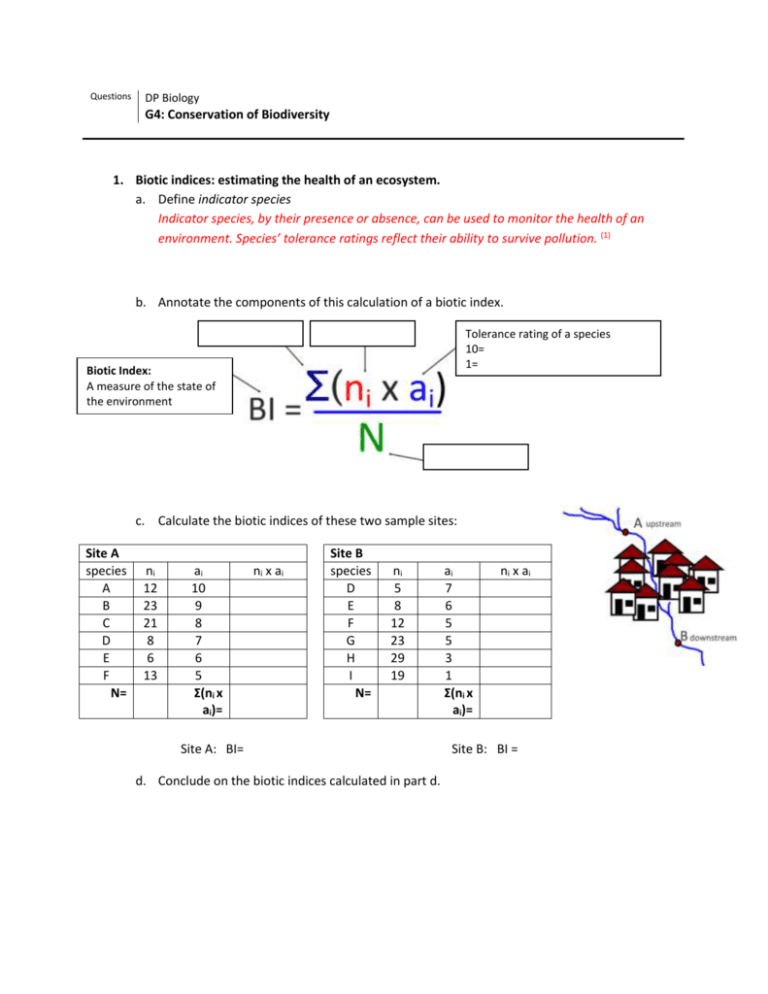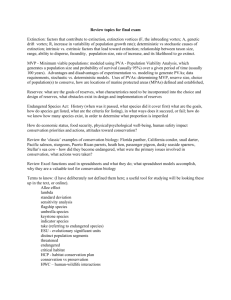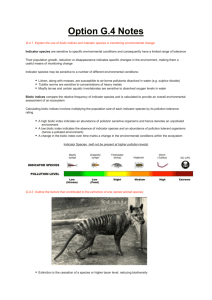G4 (HL) - Conservation of Biodiversity Questions
advertisement

Questions DP Biology G4: Conservation of Biodiversity 1. Biotic indices: estimating the health of an ecosystem. a. Define indicator species Indicator species, by their presence or absence, can be used to monitor the health of an environment. Species’ tolerance ratings reflect their ability to survive pollution. (1) b. Annotate the components of this calculation of a biotic index. Tolerance rating of a species 10= 1= Biotic Index: A measure of the state of the environment c. Calculate the biotic indices of these two sample sites: Site A species A B C D E F N= ni 12 23 21 8 6 13 ai 10 9 8 7 6 5 Σ(ni x ai)= ni x ai Site B species D E F G H I N= ni 5 8 12 23 29 19 Site A: BI= d. Conclude on the biotic indices calculated in part d. ai 7 6 5 5 3 1 Σ(ni x ai)= ni x ai Site B: BI = 2. Human impacts: Extinction a. Define extinction. b. Outline how a species becomes extinct in terms of evolution. c. What are some of the anthropogenic causes of species extinction? d. Outline the factors that contributed to the extinction of one named animal species, due to human impacts. Common name: Linnean name: Niche: Human impacts: Innate weaknesses: e. Visit the CITES database and look for endangered species in your area: http://www.cites.org/eng/resources/species.html i. Outline the classification of the species (Kingdom to species) ii. State the level of threat to the species. iii. Describe the causes of the threats to this species. iv. Outline some conservation measures that could be (or are being) done to preserve and protect this species. f. Read the debate on panda extinction here: http://tinyurl.com/n2vozt Discuss your views with your group. Interesting further reading: can we use cloning to preserve species that have gone extinct? http://ngm.nationalgeographic.com/2009/05/cloned-species/mueller-text 3. Nature reserves and conservation. a. Describe the function of a nature reserve, giving an example from your country. Use this database to find them: http://www.nationalparks-worldwide.info/ b. Outline the following biogeographical features of nature reserves that promote the conservation of diversity. Use diagrams if needed. Edge Effects Size Habitat corridors c. Outline the dangers of habitat fragmentation. 4. Management of nature reserves a. Describe active management with regard to nature reserves. b. Discuss some examples of active management strategies and their impacts. c. Outline the following aspects of a successful active management strategy. Before beginning: Human interests: Staffing: Legal: Monitoring: Funding: d. Read this article and/or watch this TED Talk outlining how successful active management strategies revived a rainforest from a devastated area of Borneo: Article: http://tinyurl.com/56a9yh Talk: http://www.ted.com/talks/willie_smits_restores_a_rainforest.html Outline some features of this project that made it successful. 5. In-situ and ex-situ Conservation a. Distinguish between in-situ and ex-situ conservation measures. b. Discuss the benefits of both in-situ and ex-situ conservation of plant and animal species, with examples. in-situ (terrestrial and aquatic reserves) ex-situ Advantages Captive breeding: Animal Examples Rehabilitation: Seed banks: Plant examples Botanic gardens:
![20-%20Conservation%20of%20Biodiversity[1]](http://s3.studylib.net/store/data/007169774_1-d8aa5010241d91dc01f2a30f36c56059-300x300.png)










